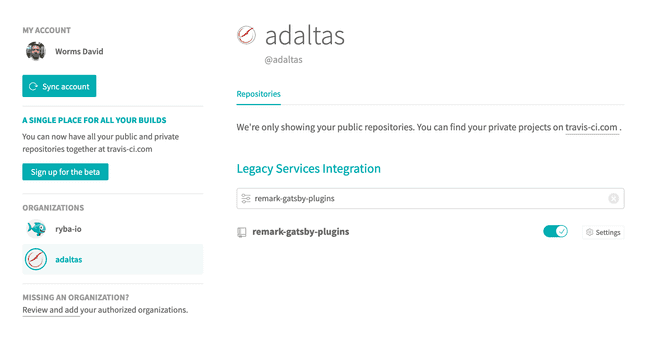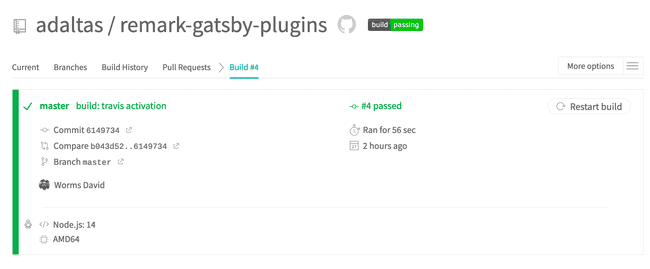Implementing steady integration CI and steady deployment (CD) on a monorepo is kind of complicated because of the variety of a number of tasks between builders and the necessity to coordinate a number of packages. This text introduces the advantages of a monorepo built-in to a CI/CD pipeline. It checks and deploys such an utility utilizing Travis CI.
Within the previous article discussing unit testing, we used Mocha and Should.js to create unit checks. They had been execuded on our native machine. Steady Integration is the apply of automating the execution a number of duties, together with unit checks execution, at any time when a commit is pushed to a distant Git repository. The CI/CD pipeline executing the checks gives feedbacks, helps the combination of options and automates the deployment of latest releases.
This text is a part of a sequence relative to JS monorepos greatest practices:
Operating all checks without delay
The lerna run command is useful in terms of operating the identical Yarn or NPM command throughout all of the packages it manages. The lerna run check executes the check command from each package deal when it’s registered.
A check script within the root package deal.json file registers the yarn check command:
{
"scripts": {
"postinstall": "husky set up",
"check": "lerna run check" }
}CI/CD activation between GitHub and Travis CI
The challenge repository used as an instance the serie of article is a hosted on GitHub. This text integrates the challenge with a CI/CD plateform to automate the execution of checks and to publish new releases to the NPM registry.
The CI/CD plateform is Travis CI. Travis was once free for all open supply tasks with none limitation. Nonetheless, after a latest acquision and the target to extend earnings (no judgement right here), this provide has been restricted. For the reason that finish of 2020, Travis CI now gives a free plan for Personal & Open-Supply Repos however it’s restricted to 10000 Credit. To be taught extra about Travis CI pricing, test our their plans.
There are a number of CI/CD platforms you possibly can select. We select Travis as a result of we now have an extended historical past of utilizing it and for the standard and ease of the plateform. The steps introduced under are comparable for various answer. In a observe up article, we are going to obtain the identical outcomes with GitHub actions.
To make use of Travis CI, you don’t have to create an account, simply sign up along with your GitHub account. As soon as logged in, go to your settings page the place your repositories are synchronized from GitHub. Should you don’t discover your repository, click on the “Sync account” button under your identify. You shall now be capable of discover your repository and to activate it.
To instruct the right way to execute the checks on the platform, Travis CI searches for a .travis.yml file on the root of the challenge. Our file is straightforward:
language: node_js
node_js:
- '14'
cache:
yarn: true
directories:
- "node_modules"
script:
- yarn checkThe yarn check on Travis CI is triggered as soon as we push the change remotely on GitHub:
echo '!.travis.yml' >> .gitignore
git add .gitignore .travis.yml package deal.json
git commit -m "construct: travis activation"
git pushOn completion, the Travis CI display screen informs in regards to the success of the execution.
Talk in regards to the CI standing
You may insert a Travis CI badge in your readme file or on another location. It signifies the standing of your present construct:
a href="https://travis-ci.org/#!/adaltas/remark-gatsby-plugins">
img src="https://api.travis-ci.org/adaltas/remark-gatsby-plugins.svg" alt="Construct Standing" />
a>In Markdown, the badge seems like:
[](https://travis-ci.org/#!/adaltas/remark-gatsby-plugins)Operating Travis CI domestically with Docker
You may acquire a completely reproductible surroundings of your Travis Docker surroundings. Just a few weeks in the past, we share particulars directions to re-create the same Travis Docker container in your native machine.
Steady supply
Checks at the moment are executed on each construct. Assuming a brand new model is current within the present commit, we are able to situation the lerna publish command from throughout the CI/CD platform.
With Lerna, we are able to use each the lerna publish from-package and lerna publish from-git instructions. I discover the second is best. It seems for the model tag within the present commit. If current, it extracts the model and publishes a brand new launch on an NPM registry.
Let’s contemplate our package deal able to graduate and the prerelease cycle is exist. For instance, we wish our title-to-frontmatter package deal to graduate from 1.0.0-alpha.3 to 1.0.0.
Travis CI should first be configured to deploy the package deal. Edit the travis.yml by including:
before_deploy:
- echo "//registry.npmjs.org/:_authToken=${NPM_TOKEN}" >> $HOME/.npmrc 2> /dev/null
deploy:
supplier: script
script: "yarn run publish"
on:
node: "14"
tags: trueThe on property is to situation the execution of the deployment to the model of Node.js, in case we check towards a number of variations, and the presence of tags within the present commit. The deployment solely happens when all situations are met.
The supplier and script properties point out the utilization of the customized command yarn run publish to deploy our package deal. The package deal.json file is up to date to mirror the newest command:
{
"scripts": {
"postinstall": "husky set up", "publish": "lerna publish from-git --yes",
"check": "lerna run check"
}
}Let’s commit the adjustments:
git commit -a -m 'construct: publish script'Deploying a package deal on the NPM registry requires consumer credentials. In fact, we don’t wish to share our credentials on a public repository. Even on a non-public repository, you shall by no means retailer any delicate data comparable to password, secrets and techniques and certificates. As a substitute, we make use of surroundings variables configured in Travis CI. The nice factor with surroundings variables when they’re properly declared, they don’t have to look in log information.
The NPM_TOKEN worth is obtained out of your NPM account. Go to “Entry Tokens” web page and click on the “Generate New Token”. From the listing, choose the “Publish” kind. NPM states that the “Automation” token is “appropriate for CI/CD workflows” nevertheless it simply didn’t work for me. I believed it is because 2FA isn’t but activated on my account.
Copy the worth and paste it within the ‘Settings > Surroundings Variables’ part of the challenge in Travis CI:
The challenge has a brand new deploy instruction and the NPM_TOKEN variable inside it’s registered in Travis CI. We at the moment are able to deploy the brand new model. The lerna model command presents the --conventional-graduate flag:
lerna model --conventional-commits --conventional-graduate
information cli utilizing native model of lerna
lerna discover cli v3.22.1
lerna information versioning impartial
lerna WARN conventional-graduate all packages
lerna information Graduating all prereleased packages
lerna information Trying for modified packages since gatsby-caddy-redirects-conf@0.1.0-alpha.3
lerna information ignoring diff in paths matching [ '**/test/**' ]
lerna information getChangelogConfig Efficiently resolved preset "conventional-changelog-angular"
Adjustments:
- gatsby-remark-title-to-frontmatter: 1.0.0-alpha.3 => 1.0.0
- gatsby-caddy-redirects-conf: 0.1.0-alpha.3 => 0.1.0
? Are you positive you wish to create these variations? Sure
lerna information execute Skipping releases
lerna information git Pushing tags...
lerna success model completedThe packages at the moment are formally obtainable to the neighborhood.
Cheat sheet
- Add a
checkscript within the rootpackage deal.jsonfile registers theyarn checkcommand:{ "scripts": { "postinstall": "husky set up", "check": "lerna run check" } } - Create a
.travis.ymlfile on the root of the challenge to instruct the right way to execute the checks on the platform:language: node_js node_js: - '14' cache: yarn: true directories: - "node_modules" script: - yarn check - Commit the adjustments:
echo '!.travis.yml' >> .gitignore git add .gitignore .travis.yml package deal.json git commit -m "construct: travis activation" git push - Add the badge to the README.md:
[](https://travis-ci.org/#!/adaltas/remark-gatsby-plugins) - To deploy the package deal, edit the
.travis.ymlby including:before_deploy: - echo "//registry.npmjs.org/:_authToken=${NPM_TOKEN}" >> $HOME/.npmrc 2> /dev/null deploy: supplier: script script: "yarn run publish" on: node: "14" tags: true - Add a script to the
package deal.json:{ "scripts": { "postinstall": "husky set up", "publish": "lerna publish from-git --yes", "check": "lerna run check" } } - Commit the adjustments:
git commit -a -m 'construct: publish script' - The
NPM_TOKENworth obtained from the NPM “Entry Tokens” web page. Choose the “Publish” token or the “Automation” token if 2FA is activated. Copy the worth and paste it within the ‘Settings > Surroundings Variables’ part of the challenge in Travis CI.
Conclusion
We went over the right way to implement a steady integration workflow in your monorepo utilizing Travis CI in addition to the right way to make a steady supply work course of to deploy your package deal on the NPM registry.
Just lately, Travis CI raises questions from the open supply neighborhood about the way forward for its open supply assist. It follows their latest announcement about adjustments to Travis CI pricing. As a response, they ensured that “assets can be found to all builders and groups in addition to enhancements to the general efficiency and stability of the platform”. However that’s merely not what’s occurring. For instance, the CI/CD pipelines of our open supply tasks began with a number of hours delays. So far as anybody can inform, they’re providing free minutes in fastened month-to-month allotments. There are solely so many complete minutes they’re keen to present out. These adjustments the place initiated in 2019 when Travis CI was acquired by Idera, a non-public fairness agency. It stays nonetheless an excellent platform for non open supply tasks.
Within the subsequent article, we cowl CI/CD utilizing GitHub Actions, a software that makes it straightforward to automate software program workflows.










